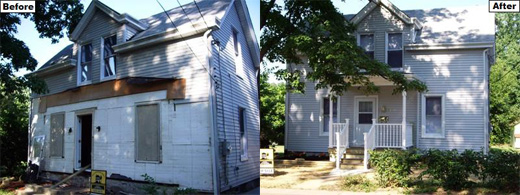
An unprecedented agreement with top mortgage lenders may help streamline the way local governments and nonprofits acquire vacant and foreclosed homes. The
National First Look Program was unveiled by HUD secretary Shaun Donovan early this month and although it received very little media attention, it has the potential to accelerate reform efforts in Cincinnati neighborhoods struggling with the after effects of the foreclosure crisis.
The new program is, among other things, a public-private partnership between HUD and the
National Community Stabilization Trust (NCST). NCST originally pioneered the 'First Look' model in 2008 in order to give local government housing providers a chance to purchase foreclosed and abandoned properties before private investors. The model has since been viewed as a success and has gained recognition as an important tool in post-housing crisis neighborhood revitalization efforts.
The goal of the National First Look Program is to expand on the trust's successes by increasing the number of financial institutions involved in the program's efforts, as well as the number of groups who are able to participate. Under the new program, any group participating in HUD's
Neighborhood Stabilization Program (NSP) will now have access to national servicers such as Fannie Mae, and Freddie Mac, as well as financial institutions such as Bank of America, Chase, Citi, U.S. Bank, Wells Fargo, and the Federal Housing Administration (FHA).
Currently, the Federal Housing Administration (FHA) offers a complementary pilot program in which NSP grantees receive an exclusive option to purchase so-called 'HUD Homes' at a discount prior to those homes being made available to private investors. The FHA pilot, alongside the new program announced this month, expands the opportunity for NSP grantees to gain access to real estate owned (REO) properties. It also gives community organizations an important 'first look' at real-estate owned properties.
"REOs sit forever in our neighborhoods and they are easy targets for all kinds of crime, so getting them sold and fixed up helps," said Matt Strass director of Marketing and Neighborhood Promotion at
Price Hill Will. "It's even better when they go to organizations that have the community's interest at heart, and not private investors that have no social investment in the community."
Hamilton County has been participating in the NCST since round one of the NSP, and according to Community Development director Susan Walsh it has worked very well.
"Through our participating communities we have been able to acquire 20 vacant and foreclosed homes through NCST, and are in the process of rehabbing them now. We have already sold one in North College Hill, and have sales contracts for two more."
The
Cincinnati Homesteading and Urban Redevelopment Corporation (HURC), the regional contact for NCST, has also experienced success, acquiring 36 properties (20 of which were for the county) in Greater Cincinnati since working with the trust. With funds from round one of the NSP already allocated and round two funds dedicated to larger projects, benefits of the new program will not be seen until round three funds are distributed. Making Friday's announcement that the
Cincinnati region will receive $6 million in round three funding all the more important.
Ed Rust, Director of HURC, wishes that HUD would have implemented this program much earlier, but still foresees numerous benefits once round three funds are allocated.
"Although HUD is coming in a little late on this…having access to HUD, FHA and VA mortgages will be extremely beneficial. Also, the program will be beneficial to lenders who will now be able to provide properties at a price that allows them not to have to market the property, pay real estate taxes, maintain the property, etc."
Rust also points out that through this process NSP funds will be reprocessed as properties are sold, creating a cycle of funding for the NSP grantees that will accelerate neighborhood recovery and begin reversing the domino effect of foreclosures and abandonment.
"Anything that reduces the number of vacant properties has a tremendous benefit on the community because property values are pulled down by vacancies. Crime, drugs and blight also increase along with vacancies. Overall, programs like this have a positive effect on the entire community, plus it’s positive for the city tax rolls…it’s an everybody wins situation."
Writer:
Kevin WrightImages ProvidedStay connected by following Kevin on Twitter
@JKevinWright
Enjoy this story?
Sign up for free solutions-based reporting in your inbox each week.